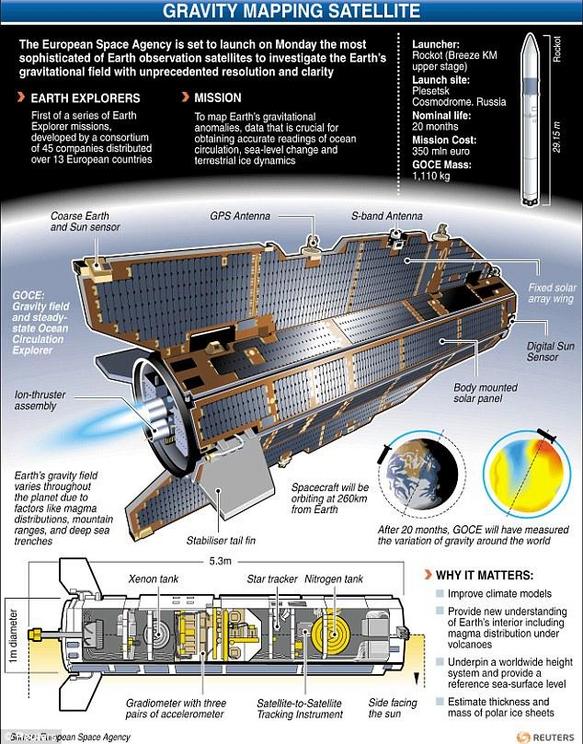Relics of 'lost continents' hidden under Antarctica are revealed by satellite images after scientists track 200 million years of tectonic plate shifts
The European Space Agency (ESA) has uncovered relics of lost continents that have hidden under Antarctica for millions of years.
Satellite images reveal a timeline of the ancient landmasses buried a mile (1.6 km) beneath the icy continent.
Scientists said the snaps shed new light on Antarctica, the 'least understood continent on Earth'.
They used data from the long-dead Gravity field and Ocean Circulation Explorer (GOCE), which plummeted into Earth after it ran out of fuel in 2013.

While the satellite has been out of action for five years, scientists are still pouring over reams of data it collected on Earth's gravitational pull.
(slide view data can be accessed at source link below)
Their research allowed them to track hidden tectonic shifts over the last 200 million years, offering fresh insights into how Antarctica formed. Pictured left is the position of the tectonics 180 million years ago, while right shows the plates 10 million years ago
A team of scientists used GOCE readings to map out the movements of Earth's tectonic plates under Antarctica.
Their research allowed them to track hidden tectonic shifts over the last 200 million years, offering fresh insights into how Antarctica formed.
'These gravity images are revolutionising our ability to study the least understood continent on Earth: Antarctica,' said co-author Fausto Ferraccioli, Science Leader of Geology and Geophysics at the British Antarctic Survey.
'In East Antarctica, we see an exciting mosaic of geological features that reveal fundamental similarities and differences between the crust beneath Antarctica and other continents it was joined to until 160 million years ago.'
Scientists combined the GOCE readings with seismological data to create 3D maps of Earth's lithosphere.
The lithosphere is made up of the crust and the molten mantle beneath Earth's surface, and includes mountain ranges, ocean backs and rocky zones called cratons.
(video can be accessed at source link below)

A team of scientists used GOCE readings to map out the movements of Earth's tectonic plates under Antarctica
Cratons are the leftovers of ancient continents embedded in continents as we know them today.
The new readings shed light on the breakup of Gondwana, a long-gone 'supercontinent' that housed what is now Antarctica.
While the landmass split some 130 million years ago, the map shows that Antarctica and Australia remained linked as recently as 55 million years ago.
The study also revealed that West Antarctica has a thinner crust than East Antarctica, which has a 'family likeness to Australia and India'.

The study revealed that West Antarctica (green) has a thinner crust than East Antarctica (blue), which has a 'family likeness to Australia and India'
WHAT WAS ESA'S GOCE SATELLITE?
The European Space Agency's (ESA) Ocean Circulation Explorer (GOCE) probe tracked the pull of Earth's gravity.
It orbited our planet for over four years, from March 2009 to November 2013.
During that period it got within 140 miles of Earth's surface - unusually low for a satellite - to maximise the accuracy of its instruments.

The European Space Agency (ESA) claims one of its sleek research satellites, dubbed the 'Ferrari of space' has plummeted somewhere into the South Atlantic ocean
Scientists are still scanning GOCE data today in a bid to understand more about processes occurring inside Earth.
In addition, the measurements are being used to improve estimates of polar ice-sheet thickness and their movement.
On 21 October 2013, the mission came to a natural end when it ran out of fuel.
Three weeks later, on 11 November, the satellite disintegrated in the lower atmosphere.
(video can be accessed at source link below)
Scientists hope to use their findings to examine how Antarctica’s geology and continental structure is affecting the melting of its ice.
GOCE mission scientist Roger Haagmans said: 'It is exciting to see that direct use of the gravity gradients, which were measured for the first time ever with GOCE, leads to a fresh independent look inside Earth – even below a thick sheet of ice.
'It also provides context of how continents were possibly connected in the past before they drifted apart owing to plate motion.'

Space mission: GOCE was launched in 2009 to map variations in Earth's gravity with unprecedented accuracy
Video can be accessed at source link below.
